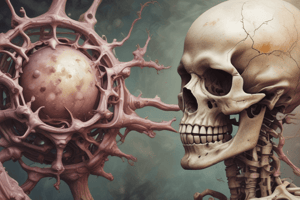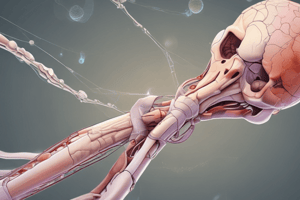Podcast
Questions and Answers
What is the characteristic pattern of malignant fibroblasts in Fibrosarcoma?
What is the characteristic pattern of malignant fibroblasts in Fibrosarcoma?
- Storiform pattern
- Spindle pattern
- Pleomorphic pattern
- Herringbone pattern (correct)
What is a characteristic of well-differentiated Fibrosarcoma?
What is a characteristic of well-differentiated Fibrosarcoma?
- Moderate intercellular matrix
- Closely resembling normal parent tissue (correct)
- Increasing mitosis
- Highly anaplastic cells
What is a characteristic of poorly differentiated Fibrosarcoma?
What is a characteristic of poorly differentiated Fibrosarcoma?
- Rare mitosis
- Moderate production of collagen
- No resemblance to parent tissue (correct)
- Resemblance to parent tissue is less pronounced
What is the hallmark of Fibrosarcoma in terms of blood vessels?
What is the hallmark of Fibrosarcoma in terms of blood vessels?
How does the production of collagen change in poorly differentiated Fibrosarcoma?
How does the production of collagen change in poorly differentiated Fibrosarcoma?
What is the grade of Fibrosarcoma with moderate mitosis?
What is the grade of Fibrosarcoma with moderate mitosis?
What is the characteristic of osteosarcoma according to the amount of bone in the lesion?
What is the characteristic of osteosarcoma according to the amount of bone in the lesion?
What is the origin of chondrosarcoma?
What is the origin of chondrosarcoma?
What is the early radiographic change of osteosarcoma?
What is the early radiographic change of osteosarcoma?
What is the radiographic feature of chondrosarcoma?
What is the radiographic feature of chondrosarcoma?
What is the characteristic radiographic appearance of osteoblastic osteosarcoma?
What is the characteristic radiographic appearance of osteoblastic osteosarcoma?
What is the type of osteosarcoma that appears as an irregular radiolucency?
What is the type of osteosarcoma that appears as an irregular radiolucency?
What is the characteristic histopathological feature of chondrosarcoma?
What is the characteristic histopathological feature of chondrosarcoma?
What is the result of infiltration of tumor cells in osteosarcoma?
What is the result of infiltration of tumor cells in osteosarcoma?
Where is the site of chondrosarcoma in the oral cavity?
Where is the site of chondrosarcoma in the oral cavity?
What is the characteristic sign seen in chondrosarcoma?
What is the characteristic sign seen in chondrosarcoma?
What is the most common site for Kaposi's sarcoma?
What is the most common site for Kaposi's sarcoma?
How many types of osteosarcoma are classified based on histologic features?
How many types of osteosarcoma are classified based on histologic features?
What is the age range for Burkitt's lymphoma?
What is the age range for Burkitt's lymphoma?
Which of the following is not a characteristic of Ewing's sarcoma?
Which of the following is not a characteristic of Ewing's sarcoma?
What is the type of Kaposi's sarcoma that affects people with AIDS?
What is the type of Kaposi's sarcoma that affects people with AIDS?
What is the characteristic of the tumor mass in Burkitt's lymphoma?
What is the characteristic of the tumor mass in Burkitt's lymphoma?
What is the virus associated with Kaposi's sarcoma?
What is the virus associated with Kaposi's sarcoma?
What is the characteristic of the cells in Kaposi's sarcoma?
What is the characteristic of the cells in Kaposi's sarcoma?
What is the percentage of cases where the Epstein-Barr viral genome is identified in the neoplastic cells in the Endemic type?
What is the percentage of cases where the Epstein-Barr viral genome is identified in the neoplastic cells in the Endemic type?
At what age are children most commonly affected by the Endemic type?
At what age are children most commonly affected by the Endemic type?
Which bones are most commonly affected by the Endemic type?
Which bones are most commonly affected by the Endemic type?
What is the characteristic appearance of the Histologic features of the Endemic type?
What is the characteristic appearance of the Histologic features of the Endemic type?
What is the age range for Multiple Myeloma?
What is the age range for Multiple Myeloma?
Which of the following is a common site for Multiple Myeloma?
Which of the following is a common site for Multiple Myeloma?
Flashcards are hidden until you start studying
Study Notes
Sarcomas
- Fibrosarcoma: a rapidly growing swelling with a herringbone pattern of malignant fibroblasts, thin-walled dilated blood vessels in poorly differentiated tumors
- Fibrosarcoma classification:
- Well-differentiated type (low grade): resembles normal parent tissue, production of collagen, increase intercellular matrix, rare mitoses
- Moderately differentiated type (intermediate grade): less resemblance to parent tissue, less production of collagen, intermediate production of intercellular matrix, moderate mitosis
- Poorly differentiated type (high grade): no resemblance to parent tissue, less production of collagen, decreasing intercellular matrix, increasing mitosis
Osteosarcoma
- Character: painful, rapidly growing swelling of the involved bone, producing bulky lesion, facial deformity, paresthesia, looseness of teeth, toothache, bleeding, nasal obstruction, pathologic fracture is common
- Types according to radiographs:
- Osteolytic type (destructive type): tumors with little tumor bone, appear as an irregular radiolucency
- Osteoblastic or sclerosing type: much tumor bone produced, resulting in sun-ray appearance
- Types according to histologic features:
- Osteoblastic
- Chondroblastic
- Fibroblastic
- Telangiectatic (osteogenic sarcoma)
Chondrosarcoma
- Arises from mesenchymal stem cells
- Site: ant part of maxilla, remnants of Meckel's cartilage
- Radiographic picture: Garrington sign (widening of the periodontal ligament), irregular radiolucency with radiopacities
- Histopathology: highly cellular, binucleated cells, lacunae contain more than two cells, pleomorphism, hyperchromatism
Ewing's Sarcoma
- Clinical features: occurs in children and young adults, pain, swelling, loosening of teeth, mucosa ulcerates, leucocytosis, fever, and raised ESR and anemia
- Mic. Endemic type: common in Africa, affects children of 7 years old
- Mic. Non-Endemic type: common in the USA, affects children of 11 years old
- Histologic features: monotonous overgrowth of undifferentiated monomorphic lymphoreticular cells, macrophages with clear cytoplasm scattered uniformly throughout the tumor, producing the characteristic starry sky appearance
Multiple Myeloma
- Definition: a malignant tumor of bone, arising from cells of bone marrow similar to plasma cells
- Etiology: unknown, risk factors include obesity, radiation exposure, family history, and certain chemicals
- Clinical features: age 40-70 years, female > male, sites: vertebrae, ribs, skull, ends of long bones, and jaw bones (mandible > maxilla), rapidly growing painful swelling, expansion of the bone, numbness, mobility of teeth, hemorrhage, and pathologic fractures
- Histopathology: cells resemble lymphocytes but are larger, intracellular glycogen is noticed, cells are in lobules or sheets
Kaposi's Sarcoma
- Definition: a sarcoma caused by HHV-8 in AIDS patients (immunodeficiency)
- Clinical features: four sub-types:
- Classic Kaposi's sarcoma: affects older men in regions where KSHV is highly prevalent, slow-growing, and most often affects only the legs
- Endemic Kaposi's sarcoma: most common in Sub-Saharan Africa, more aggressive in children
- Immunosuppression therapy-related Kaposi's sarcoma: occurs in people following organ transplantation, mostly affects the skin
- Epidemic Kaposi's sarcoma: occurs in people with AIDS, many parts of the body can be affected
- Histopathology: proliferating malignant spindle cells, slit-like vascular channels
African Jaw Lymphoma (Burkitt's Lymphoma)
- Definition: a form of malignant lymphoma in which cancer starts in immune cells called B lymphocytes
- Clinical features: age 2-14 years, site: mandible, maxilla, ethmoid and sphenoid sinuses, orbit, and visceral organs
- Types: Endemic and Non-Endemic
Studying That Suits You
Use AI to generate personalized quizzes and flashcards to suit your learning preferences.



